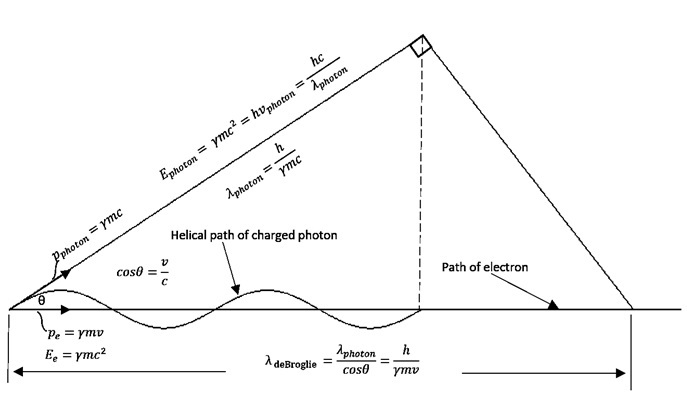September 16, 2015
In 1933 Paul A. Dirac claimed in his Nobel Prize lecture that electrons actually move at light speed, but because of their small amplitude and high frequency vibratory motion they can only be detected moving at sub-light speeds. Now a radical new hypothesis, presented at the SPIE Optics + Photonics conference in San Diego in early August, proposes that the electron is actually a helically-circulating electrically-charged spin ½ photon. This charged photon has the uncharged photon’s light-speed, energy and momentum characteristics, but carries the electron’s charge, spin of ½, and mass. The charged photon model of the electron has many of the Dirac electron’s properties.
Though moving helically at light-speed, the charged photon moves forward at the electron’s sub-light velocity. Furthermore, this circulating charged photon generates the electron’s spin ½, the electron’s de Broglie wavelength along the helical axis of the charged photon, and the electron’s superluminal phase velocity  where
where  is the electron’s velocity. The charged photon, by generating a plane wave along its helical trajectory, generates along its helical axis the quantum ‘matter wave’ of the electron described by Louis de Broglie in 1924. De Broglie won the Nobel Prize after his predicted wavelength for a moving electron was experimentally confirmed in electron diffraction experiments.
is the electron’s velocity. The charged photon, by generating a plane wave along its helical trajectory, generates along its helical axis the quantum ‘matter wave’ of the electron described by Louis de Broglie in 1924. De Broglie won the Nobel Prize after his predicted wavelength for a moving electron was experimentally confirmed in electron diffraction experiments.
Several theoretical physicists have proposed that electrons have an internal light-speed motion and may even be composed of a circulating photon. But this new hypothesis is the first to propose that a relativistically moving electron is composed of a spin ½ charged photon whose wavelength predictably decreases as the total relativistic energy of the electron (and the corresponding relativistic frequency of the charged photon composing it) increases. This relativistically decreased charged photon wavelength lies along the helically moving photon’s helical trajectory, and generates the electron’s relativistic de Broglie wavelength as well as the electron’s relativistic ‘matter wave’ equation along the circulating photon’s helical axis.
The new spin ½ charged-photon hypothesis is highly controversial, since normal photons are uncharged, have spin 1 and have no rest mass. Richard Gauthier, who proposed the new spin ½ charged photon hypothesis, suggests that the charged photon, having the electron’s charge, spin and rest mass, is a new, previously overlooked variety of photon. The electron’s mysterious wave-particle duality property can now be understood as a photon property if the electron is seen as new variety of photon. The new charged-photon hypothesis suggests a new interpretation of quantum mechanics as based on the properties of the charged photon. The model may also have implications for the creation of new photonics and electronics technologies.
This article was written by Richard Gauthier (corresponding author), Department of Chemistry and Physics, Santa Rosa Junior College, 1501 Mendocino Ave., Santa Rosa, California 95401-4395, USA
For further information, contact R. Gauthier (richgauthier@gmail.com)
“Electrons are spin ½ charged photons generating the de Broglie wavelength,” R. Gauthier, Proc. of SPIE Vol. 9570 95700D-1 (2015). [doi: 10.1117/12.2180345]















